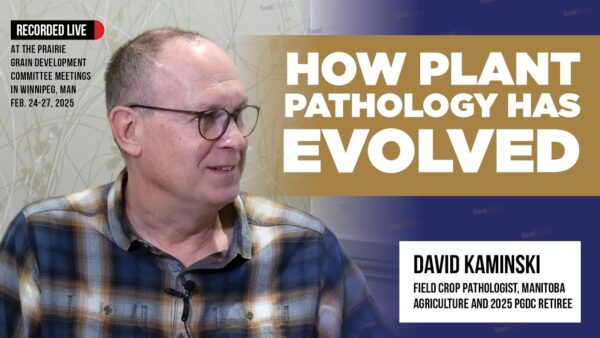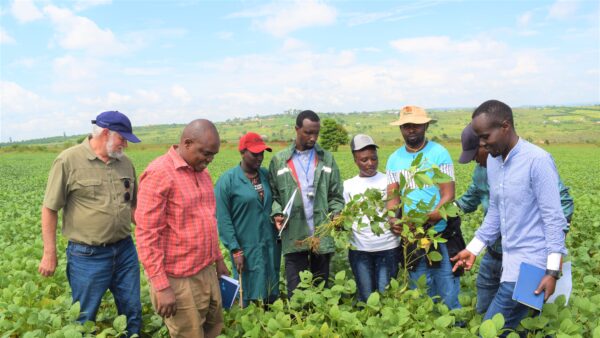In today’s fast-paced environment, it can be hard to keep up with the trends … let alone, stay ahead of them. There’s the traditional rotation of crops, the influx of more corn and soybean acres and a diverse specialty crops market, each needing an array of different products and services._x000D_
_x000D_
“Even though major crops are corn, soybeans and wheat, it’s quite a diverse marketplace,” says Norm Sutherland, who serves as Syngenta Canada district manager in Ontario. “Depending on where you are situated, we are seeing a decline in processing vegetable crops, an increase in non-GMO soybeans, and spring cereal and canola acres shifting to earlier-maturing soybeans.”_x000D_
_x000D_
David Hansen, CANTERRA SEEDS president and CEO, says one of the latest trends is the evolution in soybean genetics toward early-maturing varieties. “It’s products such as this that provide growers new opportunities,” he says. “These earlier-maturing soybeans fit good into existing crop rotations and require minimal inputs, and there’s minimal risk. This makes it easy for farmers to adopt.”_x000D_
_x000D_

_x000D_
However, corn is being driven by international seed companies, Hansen says. “They have the research and genetics and are adding new resources where they see opportunities, and right now that focus is on Western Canada,” he explains. “As maturities are developed that match our climate, we’re seeing more and more [corn] here.”_x000D_
_x000D_
Sutherland says that at Syngenta, they are planning a minimum of one to two years out. “When you’re looking at inputs, crop protection products are easier to adjust plans later on, but seed is a bit more tricky because you have to decide on a production plan 18 months before farmers will plant it,” he says._x000D_
_x000D_
Regardless of whether you’re a local or regional retailer or if you’re company has a national presence, experts say the best way to stay ahead of trends is to stay connected with your customer._x000D_
_x000D_
Connect with Your Customer_x000D_
_x000D_
“It comes down to keeping your eyes and ears open,” says Brad Pinkerton, SeCan’s Manitoba marketing representative. This can be done through several means, but a few include knowing what your sales representatives are hearing, following farmers on Twitter, meeting with farmers, attending trade shows and getting updates from grower groups._x000D_
_x000D_
A few grower groups to keep your eye on are the Canola Council of Canada, Grain Growers of Canada and the Canadian Federation of Agriculture._x000D_
_x000D_
“You have to be engaged with these types of organizations,” Hansen says._x000D_
_x000D_
However, Pinkerton cautions that sometimes what’s being reported at the national level doesn’t always match what’s happening at the local level. This is where it’s important to have a strong network of people you can trust — both locally and nationally._x000D_
_x000D_
Sutherland adds that networking with your sales team and retail partners in all geographies to try and pick up “local” insights is especially important._x000D_
_x000D_
He also pays attention to local media and makes use of Twitter._x000D_
_x000D_
“By following farmers representing different crops and geographies on Twitter, I can quickly see what’s happening at the field level,” Sutherland shares. “Most recently, it’s been the changing pests with the increase in soybean cyst nematode and white mould.”_x000D_
_x000D_
For Sutherland, Twitter helps him to better understand the spread and impact of some of these pests and how it impacts the farm._x000D_
_x000D_
Once you know what’s happening at the local level, Sutherland recommends looking at what value your business can deliver to farmers in that specific field._x000D_
_x000D_
SeCan’s Pinkerton says he spends time at trade shows listening to farmers. Specifically, he’s listening for what they are asking for, what they’re disappointed in and how his company can fill that hole._x000D_
_x000D_
“We need to know farmers’ frustrations and what’s working,” he says. “It’s all about one-on-one conversations. If you’re not on the phone with other retailers and farmers, then how else are you going to find out?_x000D_
_x000D_
“If you’re waiting for a report, it’s likely to late to be on the front end, and it takes time to build up all that seed.”_x000D_
_x000D_
It’s also important to get new products into the right hands at the local level, Pinkerton says, noting that this will give you local feedback, local data and help to kick-start things._x000D_
_x000D_
“Then it’s up to you and your team to share that experience with others,” he adds._x000D_
_x000D_
Network with Peers_x000D_
_x000D_
Networking is critical. “You have to know what your peers in the business are doing,” Pinkerton says. “Just ask them about their experience, and most people are happy to share their insight.”_x000D_
_x000D_
Ryan McCann, director of seed for Crop Production Services Canada, says he is always talking with his network to share ideas and see how they may have handled a situation or event._x000D_
_x000D_
For example, as corn and soybean acres continue to expand across Western Canada, his team is working to take a lead role in understanding those crops and being able to make reliable recommendations to customers._x000D_
_x000D_
They are doing this not only through their own research and testing, but also networking._x000D_
_x000D_
“We have a large retail network in the U.S. with experience in corn and soybeans, so I’m always in discussion with both colleagues and suppliers to make sure we learn and understand how they went through a transition of this magnitude,” McCann says._x000D_
_x000D_
Use Suppliers and Manufacturers_x000D_
_x000D_
“From a seed company perspective, understanding long-term trends is critically important,” Hansen says. “Plant breeding is on a 10-year time line. If we see trends or market demands changing, the genetics must evolve to meet the changing market demands.”_x000D_
_x000D_

_x000D_
Because suppliers and manufacturers are often planning more than one to two years out, Sutherland says you can gain a great deal of insight from having a positive relationship with them and taking the time to sit down with them to understand the impact on technologies in your trading area._x000D_
_x000D_
Don’t be afraid to “ask how they see the world changing and what the impact may be,” Sutherland says. “What do they see as opportunities?_x000D_
_x000D_
“Every company is constantly assessing how they can meet farmers changing needs.”_x000D_
_x000D_
Pinkerton says it’s also important to have access to products before they hit your shelves._x000D_
_x000D_
“You need to have success with a product on your farm or in your plots before others will want to grow it,” he says. “This will also help you know when something is not working and better protect your reputation. It allows you to make better recommendations on whose farm the product best fits and those it will not.”_x000D_
_x000D_
McCann says at Crop Production Services, they work closely with their internal development team, with breeders and seed companies. When it comes to trialing products, his team relies on a two-pronged approach. First, products start in small plots, and then as they come closer to market, they transition to field scale trials, McCann explains._x000D_
_x000D_
“I would rather have mistakes in my own plots than in a customer’s field,” he says._x000D_
_x000D_
Approach New Opportunities_x000D_
_x000D_
After taking in all the information, retailers must decide if action is needed._x000D_
_x000D_
“It’s really an ongoing dialogue with your retail partners,” Sutherland says. “It’s always changing so it’s important to assess if it the changes are significant or not to take action.”_x000D_
_x000D_
Hansen says there are lots of fundamentals that go into the evolution of any new crop type._x000D_
_x000D_
“Farmers are so adaptable to opportunities and move very quickly; they make decisions on economics,” he says._x000D_
_x000D_
In examining new opportunities, Hansen advises retailers to:_x000D_
_x000D_
• Determine the rate of return for new investments._x000D_
_x000D_
• Know what the demand is._x000D_
_x000D_
• Understand how it impacts those up and down the value chain._x000D_
_x000D_
“It’s really a chain of events that happens,” Hansen says. “It starts with processors, then moves to genetics and then is available for customers, but it works back to front and front to back.”_x000D_
_x000D_
For example, Hansen says a lot of work is being done with biofuels. In Canada, companies such as Agrisoma are working on biojet fuel and CANTERRA is a seed partner._x000D_
_x000D_
“That’s us investing in a long-term project,” he says. “There are no guarantees that it will be successful, but we decided to invest because of the long-term potential, benefits to growers and the partnership with Agrisoma.”_x000D_
_x000D_
CPS has multiple programs and varieties tied to end use programs, and McCann says that he is in constant conversation with end users to make sure his team is ahead of the curve._x000D_
_x000D_
“Even if you don’t have a lot of resources dedicated to analyzing the market, our consumptive customers have people forecasting and making these types of business decisions,” McCann shares._x000D_
_x000D_
Another important factor in approaching or implementing a new strategy is communication._x000D_
_x000D_
Sutherland says, “Communication is key,” regardless if you have a small staff or large staff. “Everyone needs to be on the same page and working with the same goal in mind.”_x000D_
_x000D_
The other important thing to recognize is that you can’t be all things to all people, Hansen says._x000D_
_x000D_
“As a company, it’s critical to stay focused and make sure what you do has value to your customers, the grower,” he says. “It’s the three-legged stool — you have to have market demand, the genetics or products, and the farmer customers.”_x000D_
_x000D_
However, Hansen recognizes that it’s not an exact science, adding that the partnership with Agrisoma is out of the ordinary._x000D_
_x000D_
Staying up on the shifting crop landscape and industry trends is “an evolution and we’re constantly working to understand and assess,” Sutherland says. “We’ve moved from an annual planning process to an ongoing planning process — this is one of the bigger changes.”_x000D_
_x000D_
_x000D_
_x000D_
The Fundamentals_x000D_
_x000D_
1. Take in as much information as you can about what’s happening at the local level._x000D_
_x000D_
2. Stay connected with your customers — the farmer._x000D_
_x000D_
3. Network and exchange information with peers._x000D_
_x000D_
4. Keep end users needs in mind._x000D_
_x000D_
5. Determine if action is needed.













